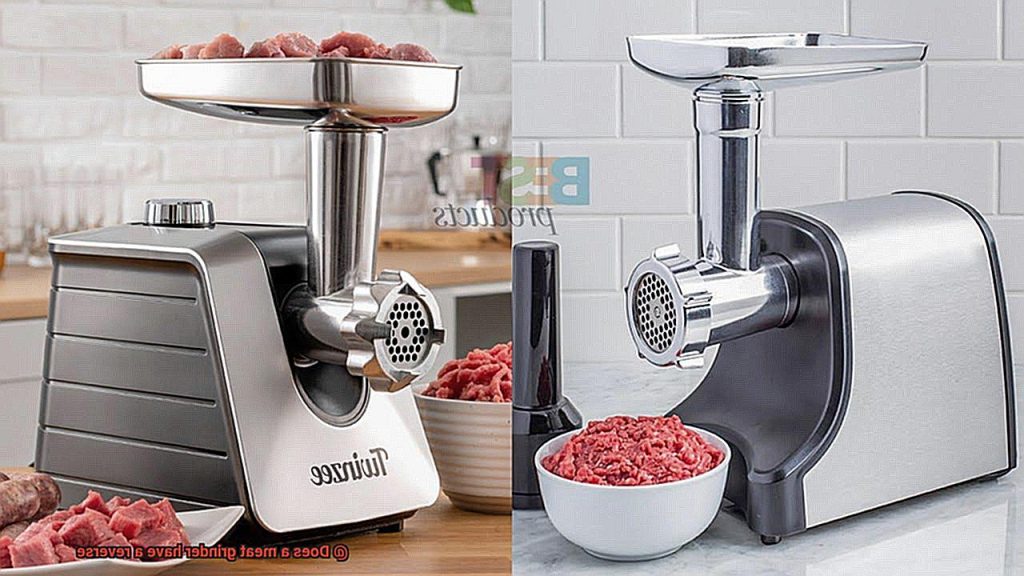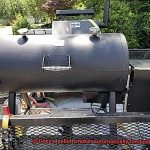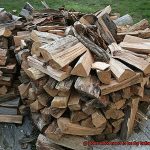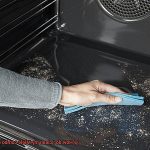Are you tired of your meat grinder getting jammed? Fret not, my friend. Did you know that reversing the grinding direction can help unclog it? It’s true. Most meat grinders have a reverse option that can come in handy when your meat is stuck in the blades.
But here’s the million-dollar question: do all meat grinders have a reverse function? Unfortunately, no. Not all models are equipped with this useful feature, and it can be challenging to identify which ones do. That’s why we’re here to help.
In this article, we’ll delve into the world of meat grinders and explore everything about the reverse function. From its benefits to how to use it, we’ve got you covered.
There are several reasons why you may need to reverse your meat grinder’s direction of grinding. One common scenario is when your meat gets tangled or caught in the blades. Reversing the machine’s direction can help loosen or free up the lodged meat.
So let’s get started on our journey through the land of meat grinders. We’ll discover which models have a reverse function, how to use it effectively, and much more. Join us as we embark on this exciting adventure together.
Contents
Do All Meat Grinders Have a Reverse Function?
The answer may not be as straightforward as you think. While some meat grinders are equipped with a reverse button, others are not. In this article, we’ll delve deeper into the subject and help you decide whether a reverse function is crucial for your grinding needs.
First and foremost, let’s examine why some meat grinders come with a reverse function. This feature can be incredibly helpful when grinding tougher cuts of meat or when there is an obstruction in the grinder. With the simple push of a button, you can easily clear any blockages and ensure that the meat is ground evenly. This saves time, effort and frustration compared to having to disassemble the grinder to remove the obstruction manually.
However, not all meat grinders come with this feature. Some models may only have a forward function, which means that if there is an obstruction, you will need to disassemble the grinder and manually remove the blockage. Although this may seem like a hassle, it’s important to remember that meat grinders without a reverse function can still be highly effective and easy to use.
When choosing a meat grinder, there are other factors to consider such as motor power, blade quality, and ease of use. If you plan on using your grinder frequently or for large quantities of meat, investing in a model with a reverse function may be worth it to ensure that you can easily handle any obstacles that arise during the grinding process.
It’s also vital to note that some people prefer manual meat grinders over electric ones. While manual grinders may not have a reverse function, they can still be very effective and are often more affordable than their electric counterparts.
To help you make an informed decision, here are some pros and cons of a meat grinder with a reverse function:
Pros
- Can easily clear any obstructions
- Saves time and effort
- Ensures that the meat is ground evenly
Cons
- May be more expensive
- Not necessarily a make-or-break feature
- For occasional home use, a basic grinder without a reverse function may suffice.
The Benefits of Having a Reverse Function on a Meat Grinder
If you’re an avid chef or a professional cook, then you know that having the right tools is crucial in creating the perfect meal. A meat grinder is an essential tool for any home cook or professional chef who wants to grind meat to their desired texture. However, have you ever considered the benefits of having a reverse function on your meat grinder? In this blog post, we’ll delve into the advantages of having a reverse function and why it’s worth considering when purchasing a meat grinder.
Firstly, let’s discuss clogging. Grinding tougher cuts of meat can be challenging and frustrating when the blades come to a halt because the meat has become stuck in the blades or auger. This problem can be time-consuming and damaging to your grinder. However, with a reverse function, you can easily switch to reverse mode and dislodge any meat that may be stuck. This not only saves time but also helps prevent damage to your grinder.
Cleaning your grinder can also be a hassle. Small pieces of meat or fat can get stuck in the blades or auger, making it difficult to clean thoroughly. However, by using the reverse function, you can easily push any remaining meat or fat out of the grinder, making it much easier to clean and maintain. This saves time and ensures that your grinder stays in top condition.
Another benefit of having a reverse function is during sausage stuffing. Air pockets can form within the casing during stuffing, which can affect the final texture and taste of the sausage. By using the reverse function, you can release any trapped air within the casing, resulting in a better-quality sausage. This may seem like a small detail but it can make a big difference in the final product.
In summary, having a reverse function on your meat grinder provides several benefits that are definitely worth considering when purchasing a meat grinder. Here is a list of these benefits:
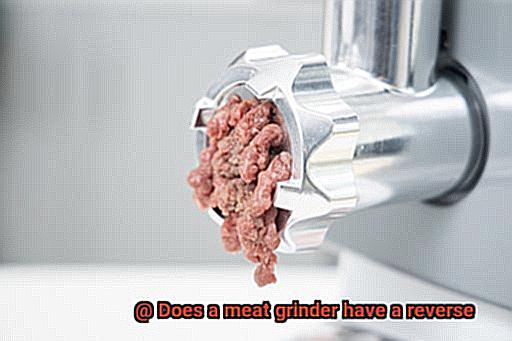
- Prevents clogging
- Helps with cleaning and maintenance
- Improves sausage quality
Types of Meat Grinders with Reverse Functions
Meat grinders are a kitchen staple for home cooks and professional chefs alike. They allow you to customize the texture and consistency of your meat, making it easier to create delicious dishes like burgers, sausages, and meatballs. However, not all meat grinders are created equal – some come with a reverse function that can make the grinding process smoother and more efficient. In this article, we’ll explore the different types of meat grinders that come with a reverse function.
Electric Meat Grinders:
Electric meat grinders are the most popular type on the market. They use a motor to power the grinder, and many models come with a reverse function. This feature allows you to change the direction of the auger – the part that pushes the meat through the blades – which can help prevent blockages and ensure even grinding. With an electric meat grinder with a reverse function, you can easily grind large quantities of meat without worrying about clogs.
Manual Meat Grinders:
Manual meat grinders require more effort since you need to turn a crank to grind the meat. However, some manual models come equipped with a reverse function as well. This feature is typically activated by turning the handle in the opposite direction, and it’s useful if you want more control over the grinding process. Manual meat grinders with a reverse function are a great option for those who enjoy grinding small quantities of meat or want to have more control over their grinding experience.
Commercial-Grade Meat Grinders:
For heavy-duty use, commercial-grade meat grinders are designed to grind large quantities of meat quickly and efficiently. Many commercial-grade models come equipped with a reverse function, which can help prevent clogs and jams during use. While these models may be more expensive than electric or manual grinders, they’re an excellent investment for those who frequently grind large quantities of meat.
Forward-Only Meat Grinders:
Some lower-end models may only have a forward function, which means that you’ll need to manually clear any blockages that occur during the grinding process. These models are typically more affordable than those with a reverse function, but they can be frustrating to use if you encounter clogs or jams. If you plan on using your grinder frequently or for larger quantities of meat, it’s worth investing in a model with a reverse function.
Hybrid Meat Grinders:
A hybrid meat grinder combines the convenience of an electric grinder with the control of a manual one. These models typically come with a reverse function and are an excellent option for those who want the best of both worlds. Hybrid meat grinders are especially useful if you want to grind small quantities of meat quickly or if you want more control over the texture and consistency of your meat.
How to Use the Reverse Function on Your Meat Grinder
Meat grinders are a versatile kitchen tool that can be used to grind meat, make sausage, and even mix meat and seasonings. However, sometimes the grinding process can go awry and you may encounter blockages or clogs. This is where the reverse function on your meat grinder comes in handy. Here’s a step-by-step guide on how to use the reverse function on your meat grinder.
Locate the Reverse Switch
Before you start using the reverse function, you need to locate the switch on your meat grinder. Most modern meat grinders have a switch located near the power button or on the side of the machine.
Turn off and Unplug the Machine
Always turn off and unplug your meat grinder before using the reverse function. This ensures your safety and prevents any accidents from occurring.
Switch to Reverse Mode
Once you’ve located the switch, switch it to the reverse position. This will cause the blades to spin in the opposite direction, pushing any stuck meat or bone back out of the grinder.
Feed a Small Amount of Meat into the Grinder
After switching to reverse mode, turn on your meat grinder and feed a small amount of meat into the grinder. The reverse function should push out any stuck meat or bone pieces from previous use. If necessary, repeat this process until the machine runs smoothly again.
Don’t Overuse the Reverse Function
While the reverse function can be useful in clearing blockages or clogs, it’s important not to overuse it. Extended periods of time in reverse mode can damage your meat grinder’s motor. Therefore, it’s best to use it only when necessary and for short periods of time.
Bonus Tip: Mix Meat and Seasonings with Ease
In addition to clearing blockages, you can also use the reverse function to mix meat and seasonings in your grinder without taking apart the machine. Simply switch to reverse mode and run the mixture through a few times until well blended.
Troubleshooting Tips for Using the Reverse Function on Your Meat Grinder
When it comes to using the reverse function on your meat grinder, there are certain issues that may arise and cause inconvenience. Here are some troubleshooting tips to help you tackle those problems and ensure the smooth operation of your meat grinder.
Clogging Issues
One of the most common issues that you may face while grinding meat is clogging. The reverse function can be a lifesaver in such situations, but it won’t work if the machine is clogged. It is essential to clear out the clog before using the reverse function. You can do this by first turning off and unplugging the grinder. Then, disassemble it and remove any large pieces of meat or fat that are causing the clog. Afterward, use a small brush or toothbrush to clean out any remaining debris from the blades and other parts of the grinder. Once you have cleaned it out, reassemble the grinder and try using the reverse function again.
Overheating Issues
Another issue that you may encounter while using the reverse function is overheating. Overheating occurs when you use your meat grinder for an extended period, causing it to become hot and stop working. To prevent this issue, ensure that you do not use your meat grinder for too long at a time. Allow it to cool down between uses to avoid overheating.
Not Working At All
Sometimes, despite your best efforts, the reverse function on your meat grinder may not work at all. This could be due to various factors like a malfunctioning motor or a defective switch. If you face this issue, consult your user manual or contact the manufacturer for assistance. You may need to take your meat grinder in for repairs or replace it altogether.
Proper Assembly and Lubrication
Before using the reverse function, ensure that your meat grinder is correctly assembled and lubricated. Proper assembly and lubrication will prevent unnecessary wear and tear on the machine and make it easier to operate. Also, ensure that your meat grinder is plugged in and turned on before attempting to use the reverse function.
Gentle Pressure
While using the reverse function, apply gentle pressure. Too much force could cause the machine to jam or break. Remember, the reverse function is designed to help loosen any stuck pieces of meat or fat; it’s not meant to force them through the grinder.
Advantages and Disadvantages of Manual vs Electric Meat Grinders
Grinding your own meat at home can be a great way to ensure that the meat you consume is fresh, high-quality, and free from additives. However, choosing between a manual or electric meat grinder can be a daunting task. Fear not. We have researched the advantages and disadvantages of both options to help you make an informed decision.
Let’s start with manual meat grinders. One of the most significant advantages of manual grinders is their affordability. They are also incredibly portable, making them perfect for outdoor activities like camping or hunting trips. Additionally, manual grinders give you greater control over the grinding process as you can adjust the speed and pressure as needed. They also tend to have fewer parts and are easier to clean.
However, there are some downsides to using a manual grinder. They require physical effort to operate, which can be tiring if you’re grinding large quantities of meat. Manual grinders can also be time-consuming, making them less ideal for busy individuals.
Electric meat grinders, on the other hand, offer several advantages worth considering. One of the most significant benefits of electric grinders is their speed and efficiency. They can grind meat faster than manual grinders and require less physical effort, making them an excellent option for those with limited mobility or strength. Electric grinders also come with various settings that allow you to adjust the texture of your meat, making them versatile for different recipes.
However, electric meat grinders do have some drawbacks to keep in mind. They tend to be more expensive than manual grinders and may have more parts that need cleaning. Additionally, they may not be as portable as manual grinders.
Ultimately, the choice between a manual or electric meat grinder comes down to personal preference and needs. If you grind meat occasionally or in smaller quantities, a manual grinder may suffice. However, if you frequently grind large amounts of meat or need greater efficiency, an electric grinder may be the better choice. Remember to consider the advantages and disadvantages before making your final decision.
In summary, here are some key points to consider when deciding between a manual or electric meat grinder:
Advantages of Manual Grinders
- More affordable
- Portable
- Greater control over the grinding process
- Fewer parts to clean
Disadvantages of Manual Grinders
- Require physical effort to operate
- Time-consuming for larger quantities of meat
Alternatives to Electric Meat Grinders with Reverse Functions
Luckily, there are several alternatives available that can get the job done just as well. Let’s explore some of the best options.
Firstly, manual meat grinders are a fantastic alternative. While they do require physical effort to turn the crank and grind the meat, they are often just as effective as their electric counterparts. Not only that, but manual meat grinders are often more affordable and easier to clean than electric models. Plus, using one of these grinders is a great way to get in a bit of exercise while preparing your meal.
Another option is to use a food processor or blender with a meat grinding attachment. While these machines may not be specifically designed for meat grinding, they can still produce ground meat of good quality. However, it’s important to note that using these machines for meat grinding can be more time-consuming and may result in ground meat with a different texture than traditional meat grinders.
Lastly, if you don’t want to invest in a meat grinder or use one of the alternatives mentioned above, pre-ground meat is always an option. Although this may not give you complete control over the texture and quality of your ground meat, it is still a convenient choice for those who don’t have access to a meat grinder.
DBxt3El76zo” >
Conclusion
To sum up, a reverse function on your meat grinder can save you time and effort when grinding tougher cuts of meat or dealing with obstructions. While not all meat grinders have this feature, it’s worth considering when purchasing a new one. Electric meat grinders are the most popular type and often come equipped with a reverse function, but manual models also offer this option for those who prefer more control over their grinding experience.
Using the reverse function on your meat grinder requires proper assembly and lubrication techniques, as well as gentle pressure to avoid jamming or breaking the machine. Clearing clogs before using the reverse function and allowing your grinder to cool down between uses can also help ensure smooth operation.
While electric meat grinders may be more efficient, manual models are affordable and portable, making them ideal for outdoor activities like camping or hunting trips. If you don’t want to invest in a dedicated meat grinder, alternatives such as food processors or pre-ground meat can also be used.
Ultimately, choosing between a manual or electric meat grinder with a reverse function depends on your personal needs and preferences. Consider factors such as frequency of use, quantity of meat being ground, and budget before making your final decision.

